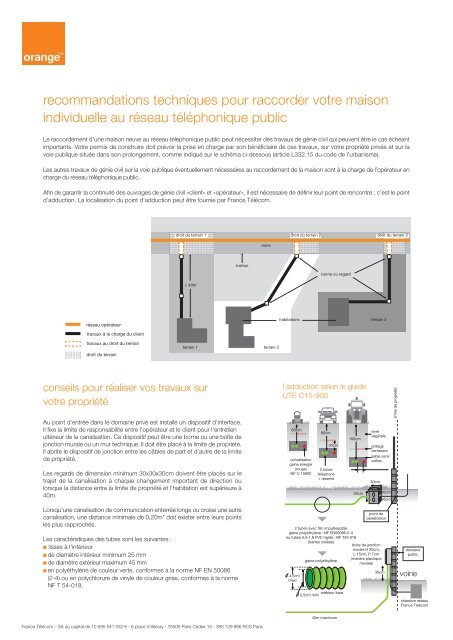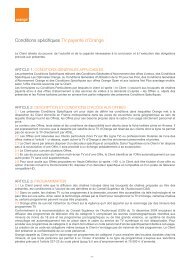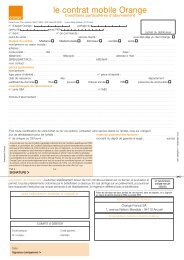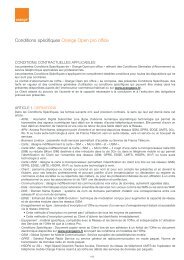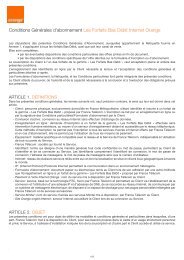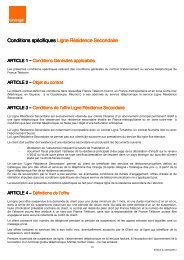le raccordement télécom en cas de construction ... - France Telecom
le raccordement télécom en cas de construction ... - France Telecom
le raccordement télécom en cas de construction ... - France Telecom
Create successful ePaper yourself
Turn your PDF publications into a flip-book with our unique Google optimized e-Paper software.
ecommandations techniques pour raccor<strong>de</strong>r votre maison<br />
individuel<strong>le</strong> au réseau téléphonique public<br />
Le <strong>raccor<strong>de</strong>m<strong>en</strong>t</strong> d’une maison neuve au réseau téléphonique public peut nécessiter <strong>de</strong>s travaux <strong>de</strong> génie civil qui peuv<strong>en</strong>t être <strong>le</strong> <strong>cas</strong> échéant<br />
importants. Votre permis <strong>de</strong> construire doit prévoir la prise <strong>en</strong> charge par son bénéficiaire <strong>de</strong> ces travaux, sur votre propriété privée et sur la<br />
voie publique située dans son prolongem<strong>en</strong>t, comme indiqué sur <strong>le</strong> schéma ci-<strong>de</strong>ssous (artic<strong>le</strong> L332.15 du co<strong>de</strong> <strong>de</strong> l’urbanisme).<br />
Les autres travaux <strong>de</strong> génie civil sur la voie publique év<strong>en</strong>tuel<strong>le</strong>m<strong>en</strong>t nécessaires au <strong>raccor<strong>de</strong>m<strong>en</strong>t</strong> <strong>de</strong> la maison sont à la charge <strong>de</strong> l’opérateur <strong>en</strong><br />
charge du réseau téléphonique public.<br />
Afin <strong>de</strong> garantir la continuité <strong>de</strong>s ouvrages <strong>de</strong> génie civil «cli<strong>en</strong>t» et «opérateur», il est nécessaire <strong>de</strong> définir <strong>le</strong>ur point <strong>de</strong> r<strong>en</strong>contre : c’est <strong>le</strong> point<br />
d’adduction. La localisation du point d’adduction peut être fournie par <strong>France</strong> Télécom.<br />
réseau opérateur<br />
travaux à la charge du cli<strong>en</strong>t<br />
travaux au droit du terrain<br />
droit du terrain<br />
conseils pour réaliser vos travaux sur<br />
votre propriété<br />
Au point d'<strong>en</strong>trée dans <strong>le</strong> domaine privé est installé un dispositif d'interface.<br />
Il fixe la limite <strong>de</strong> responsabilité <strong>en</strong>tre l'opérateur et <strong>le</strong> cli<strong>en</strong>t pour l'<strong>en</strong>treti<strong>en</strong><br />
ultérieur <strong>de</strong> la canalisation. Ce dispositif peut être une borne ou une boîte <strong>de</strong><br />
jonction mura<strong>le</strong> ou un mur technique. Il doit être placé à la limite <strong>de</strong> propriété.<br />
Il abrite <strong>le</strong> dispositif <strong>de</strong> jonction <strong>en</strong>tre <strong>le</strong>s câb<strong>le</strong>s <strong>de</strong> part et d’autre <strong>de</strong> la limite<br />
<strong>de</strong> propriété.<br />
Les regards <strong>de</strong> dim<strong>en</strong>sion minimum 30x30x30cm doiv<strong>en</strong>t être placés sur <strong>le</strong><br />
trajet <strong>de</strong> la canalisation à chaque changem<strong>en</strong>t important <strong>de</strong> direction ou<br />
lorsque la distance <strong>en</strong>tre la limite <strong>de</strong> propriété et l’habitation est supérieure à<br />
40m.<br />
Lorsqu'une canalisation <strong>de</strong> communication <strong>en</strong>terrée longe ou croise une autre<br />
canalisation, une distance minima<strong>le</strong> <strong>de</strong> 0,20m* doit exister <strong>en</strong>tre <strong>le</strong>urs points<br />
<strong>le</strong>s plus rapprochés.<br />
Les caractéristiques <strong>de</strong>s tubes sont <strong>le</strong>s suivantes :<br />
■ lisses à l'intérieur<br />
■ <strong>de</strong> diamètre intérieur minimum 25 mm<br />
■ <strong>de</strong> diamètre extérieur maximum 45 mm<br />
■ <strong>en</strong> polyéthylène <strong>de</strong> cou<strong>le</strong>ur verte, conformes à la norme NF EN 50086<br />
(2-4) ou <strong>en</strong> polychlorure <strong>de</strong> viny<strong>le</strong> <strong>de</strong> cou<strong>le</strong>ur grise, conformes à la norme<br />
NF T 54-018.<br />
<strong>France</strong> Télécom – SA au capital <strong>de</strong> 10 595 541 532 € - 6 place d’Al<strong>le</strong>ray - 75505 Paris Ce<strong>de</strong>x 15 - 380 129 866 RCS Paris<br />
droit du terrain 1 droit du terrain 2 droit du terrain 3<br />
> 40m<br />
trottoir<br />
voirie<br />
terrain 1 terrain 2<br />
habitations<br />
60cm<br />
XXXXXXXXXXXX<br />
cohabitation<br />
gaine énergie<br />
(rouge)<br />
NF-C 15900<br />
80cm<br />
XXXXXXXXXXXX<br />
30cm<br />
2 tubes<br />
téléphone<br />
+ réserve<br />
100cm<br />
2 tubes avec filin imputrescib<strong>le</strong><br />
gaine polyéthylène : NF EN50086-2-4<br />
ou tubes 4,5-1,8 PVC rigi<strong>de</strong> : NF T54.018<br />
O 4,5cm<br />
maxi<br />
(barres collées)<br />
borne ou regard<br />
l’adduction selon <strong>le</strong> gui<strong>de</strong><br />
UTE C15-900<br />
gaine polyéthylène<br />
intérieur lisse<br />
O 2,5cm mini<br />
40m maximum<br />
XXXXXXXXXXXX<br />
30cm<br />
terrain 3<br />
terre<br />
végéta<strong>le</strong><br />
grillage<br />
vertisseur<br />
sab<strong>le</strong> sans<br />
caillou<br />
30cm<br />
30cm<br />
10cm<br />
point <strong>de</strong><br />
pénétration<br />
boite <strong>de</strong> jonction<br />
mura<strong>le</strong> H 20cm,<br />
L 15cm, P 7cm<br />
(matière plactique<br />
moulée)<br />
30cm<br />
limite <strong>de</strong> propriété<br />
domaine<br />
public<br />
voirie<br />
chambre réseau<br />
<strong>France</strong> Télécom
technical recomm<strong>en</strong>dations to connect your house to the public<br />
te<strong>le</strong>phone network<br />
Connecting a new house to the te<strong>le</strong>phone network may require civil <strong>en</strong>gineering work, which may be significant in some <strong>cas</strong>es. Your building<br />
permit must make provisions for this work, which is carried out on your property and the public road located alongsi<strong>de</strong> your house as indicated<br />
on the diagram below (artic<strong>le</strong> L332.15 of the Town Planning Act).<br />
Other civil <strong>en</strong>gineering work on the public road, which may be necessary to connect your home, is the responsibility of the carrier in charge<br />
of the public te<strong>le</strong>phone system.<br />
To guarantee the continuity of "customer" and "carrier" civil <strong>en</strong>gineering work, it is necessary to d<strong>en</strong>tify where they meet: this is cal<strong>le</strong>d the supply<br />
point. <strong>France</strong> Te<strong>le</strong>com can tell you where the supply point is located.<br />
operator network<br />
work paid by the customer<br />
work land law<br />
land law<br />
> 40m<br />
pavem<strong>en</strong>t<br />
Plot 1 Plot 2<br />
few recomm<strong>en</strong>dations to help you carry out<br />
the work on your property<br />
An interface system is instal<strong>le</strong>d at the <strong>en</strong>trance to your private property.<br />
It establishes who will be responsib<strong>le</strong> (i.e. thecustomer or the carrier) for any<br />
later cabling maint<strong>en</strong>ance work.<br />
This system can be a wall-mounted junction box/terminal or a technical wall. It<br />
must be placed on the boundary of the property. It houses the junction <strong>de</strong>vice<br />
(betwe<strong>en</strong> the cab<strong>le</strong>s and the boundary of the property).<br />
Op<strong>en</strong>ings measuring 30 x 30 x 30 cm must be placed alongsi<strong>de</strong> the cab<strong>le</strong><br />
tr<strong>en</strong>ch at each major change in direction or wh<strong>en</strong> the distance betwe<strong>en</strong> the<br />
property's boundary and the dwelling is over 40 m.<br />
Wh<strong>en</strong> the buried communication cab<strong>le</strong>s follow of cross another cab<strong>le</strong> tr<strong>en</strong>ch,<br />
a distance of 0.20m(minimum) must be maintained betwe<strong>en</strong> the two points.<br />
The characteristics of the tubes are as follows:<br />
■ smooth insi<strong>de</strong><br />
■ interior diameter minimum 25 mm,<br />
■ interior diameter minimum 45 mm,<br />
■ ma<strong>de</strong> from gre<strong>en</strong> polyethy<strong>le</strong>ne which complies with the norm<br />
NF EN 50086 (2-4) or grey polyvinyl chlori<strong>de</strong> which complies with norm<br />
NF T 54-018.<br />
<strong>France</strong> Télécom – SA au capital <strong>de</strong> 10 595 541 532 € - 6 place d’Al<strong>le</strong>ray - 75505 Paris Ce<strong>de</strong>x 15 - 380 129 866 RCS Paris<br />
land law 1 land law 2 land law 3<br />
public road carrier network<br />
houses<br />
60cm<br />
XXXXXXXXXXXX<br />
terminal or op<strong>en</strong>ing<br />
supply according to the<br />
UTE C15-900 gui<strong>de</strong><br />
80cm<br />
XXXXXXXXXXXX<br />
30cm<br />
cohabitation<br />
with <strong>en</strong>ergy gain<br />
(red) 2 tubes<br />
NF-C 15900 te<strong>le</strong>phone<br />
+ reserve<br />
100cm<br />
2 tubes with rot proof wire<br />
polyethy<strong>le</strong>ne : NF EN50086-2-4<br />
or tubes 4,5-1,8 PVC rigid : NF T54.018<br />
O 4,5cm<br />
maxi<br />
(stuck bars)<br />
polyethy<strong>le</strong>ne shead<br />
smooth interior<br />
O 2,5cm mini<br />
40m maximum<br />
XXXXXXXXXXXX<br />
30cm<br />
Plot 3<br />
topsoil<br />
property limit<br />
warning<br />
grid<br />
sands without<br />
pebb<strong>le</strong>s<br />
30cm<br />
junction box on wall<br />
H 20cm,<br />
L 15cm, P 7cm<br />
(mol<strong>de</strong>d plastic)<br />
30cm<br />
10cm<br />
point of<br />
p<strong>en</strong>etration<br />
30cm<br />
public domain<br />
road<br />
Termination box<br />
<strong>France</strong> Télécom


